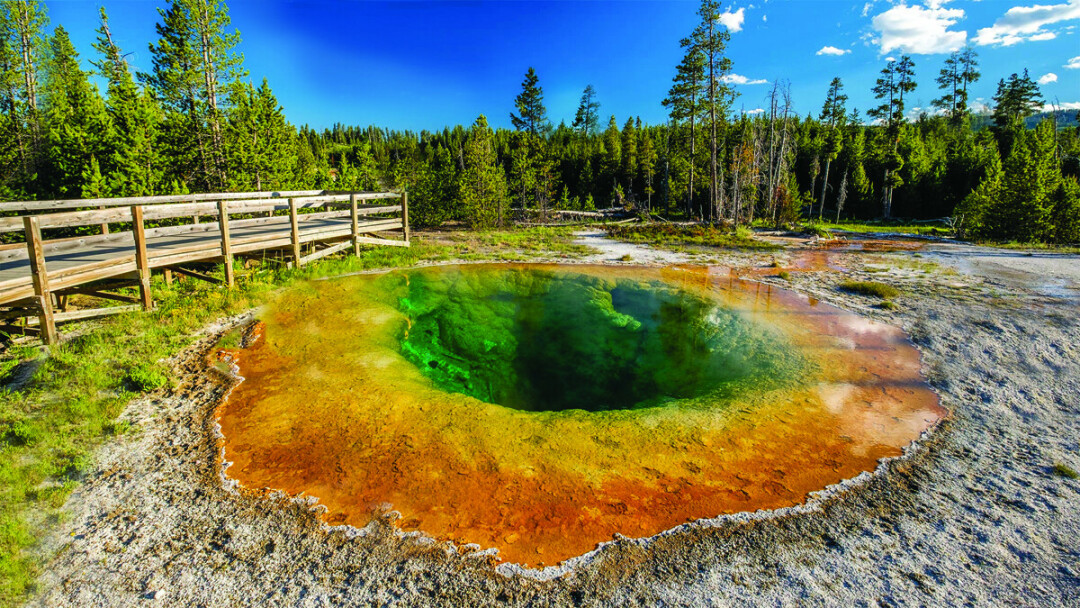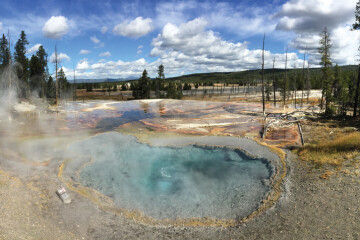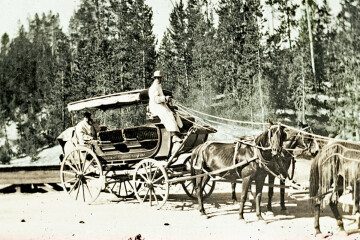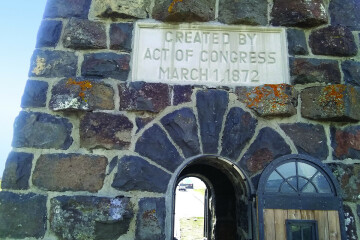Top 10 Yellowstone Bucket-List Destinations

For 150 years, Yellowstone National Park has provided retreats for millions—to embrace the great outdoors, study the wonders of nature, and appreciate America’s hard work to preserve natural, sublime landscapes. With two million acres of wilderness, the world’s first national park hosts a plethora of sights you ought to see at least once. Continue reading to learn about the top ten bucket list locations to see this year in Yellowstone National Park!
Steamboat Geyser
An unpredictable pillar of superheated steam, this thermal feature is located in the Norris Geyser Basin and boasts major eruptions that can reach over 300 feet high. The spray from its two thermal vents has helped classify the hydrothermal feature as the world’s largest active geyser, and major eruptions are said to drown out nearby conversations with noise, as well as pepper nearby vehicles with debris. With even minor eruptions commonly reaching up to 40 feet every 2-5 minutes, this landmark is an exciting option for anyone interested in seeing the power of steam up close.
Biscuit Basin
Home to Jewel Geyser, Mustard Spring, Avoca Spring, and Sapphire Pool, this collection of hydrothermal features can be appreciated from the basin’s looping boardwalk trail. Visitors can expect to be awed by geyser eruptions every 7-10 minutes, and by the variety of thermophilic microorganisms coloring the surrounding hot springs different hues of yellow, orange, brown, and green. Biscuit Basin’s Sapphire Pool is considered one of the most beautiful blue pools in the whole park!
Yellowstone Lake
With a whopping 141 miles of shoreline, Yellowstone Lake exists as the largest high-elevation lake and the largest host of wild Cutthroat Trout populations in North America. The bottom of the lake is home to an abundance of submerged hydrothermal features similar to its surroundings, with geysers, hot springs, and fumaroles providing heat and nutrients for an abundance of aquatic ecosystems. However, swimming in the lake is not recommended, as average surface temperatures in the water sit at a chilly 41 degrees Fahrenheit.
West Thumb’s Fishing Cone
Located in the West Thumb Geyser Basin next to Yellowstone Lake, the Fishing Cone has gained popularity due to its fascinating history. After a member of the Park’s 1870 Washburn Expedition accidentally lost a trout into the hot spring, the fish was quickly boiled and cooked. Once discovered, the accident was reproduced by park employees, and tourists would often arrive dressed up as chefs for pictures at the geyser. Soon, the hydrothermal feature began gaining notoriety through several monikers such as “Fishpot Spring,” “Chowder Pot,” and “Fisherman’s Kettle.” Though the act of “cook-on-the-hook” fishing is prohibited now, the Fishing Cone can still be visited alongside other unique thermal features within the basin.
Sheepeater Cliff
On the Norris-to-Mammoth section of Yellowstone’s Grand Loop Road, visitors might have the opportunity to notice black, hexagonal pillars of stone rising upwards and forming a steep drop-off. These unique structures can be found at Sheepeater Cliff, named after Eastern Shoshone Indians known as Tukudika, or “Sheep Eaters.” The formation is made from columnar basalt, which fractured into hexagonal shapes as the basalt cooled approximately 500,000 years ago. Nearby, a picnic area allows visitors to bring out their inner geologist and appreciate the natural wonders over lunch.
Lamar River Trailhead
Hardcore hikers will chomp at the bit to learn that a journey into the Lamar River Trailhead provides access to four isolated, backcountry excursions: the Lamar River, Specimen Ridge, Cache Creek, and Miller Creek Trails. With the shortest, Miller Creek Trail, spanning an impressive 7.4 miles, visitors can expect any of the paths they choose to lead to a variety of backcountry campgrounds and beautiful surroundings. Just be aware of all wildlife regulations, as bears, wolves, elk and bison populate the area.
Dragon’s Mouth Spring
Affectionately referred to as “The Belcher” in the past, this acidic mud pot in Yellowstone’s Mud Volcano area greets visitors with the ominous sight of a cave that spews murky, boiling water and shoots steam from its opening. Deep within, gasses create pressure against steam and the cave walls within, creating unique noises that might convince visitors that a gigantic, unseen creature dwells inside. Be careful around any mud pots: those like Yellowstone’s Sulfur Caldron can hold boiling water with pH levels as low as 1.4—as acidic as stomach acid!
Firehole River Swim Area
Surrounded by geothermal features that contribute heated water with dissolved minerals, the Firehole River flows through significant geyser basins in Yellowstone National Park. In contrast to its name, the water is usually only a bit warmer than other rivers, and maintains consistent populations of both brown and rainbow trout. While usually closed until midsummer due to dangerous water levels and currents, visitors can occasionally take advantage of the Firehole River Swim Area to cool down and appreciate the landscape’s rugged beauty. Be sure to check the swimming area’s closure status before you pack those swimming trunks.
Natural Bridge Trail
Usually closed until the beginning of June to allow resident bears the opportunity to feed on spawning trout, this hike takes adventurers on a 2.5 mile excursion to witness a 51-foot-tall cliff of rhyolite that has been carved away by Bridge Creek to form a natural bridge. While the bridge itself is closed off from traffic to protect both the fragile landmark (and visitors), hikers can enjoy some marvelous scenery and a bit of exercise at the same time. Make sure the trail is open before you go, but be sure not to pass up this hiking opportunity if you have the chance.
Morning Glory Pool
Named after its visual similarity to the delicate flower, this hot spring in the Upper Geyser Basin boasts one of the most striking exhibits for visitors to enjoy. With (relatively) cooler temperatures for thermophilic (heat-loving) microbes to thrive in, this hydrothermal feature takes on a yellow and green hue that provides stark contrast against its surroundings. While average temperatures within Morning Glory Pool have begun to cool, altering its coloration, the exhibit remains one of Yellowstone National Park’s most vibrant and iconic sites.
Scores of remarkable, almost unbelievable natural processes exist within Yellowstone National Park, and most who visit seldom see everything through a single exploration. The vast variety of unique hydrothermal features and systems create once-in-a-lifetime opportunities for visitors to witness amazing events, forge powerful memories, and understand the importance of conserving land for future generations. With this in mind, if you find yourself heading to Yellowstone, be sure to keep these interesting bucket list items handy, and try to visit at least some of them first-hand!





